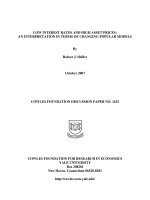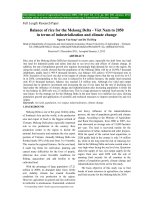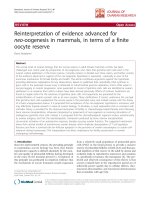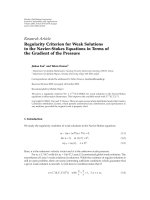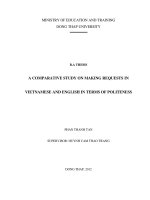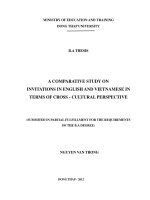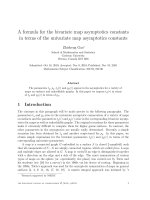FRACTIONAL POISSON PROCESS IN TERMS OF ALPHA STABLE DENSITIES by ...
Bạn đang xem bản rút gọn của tài liệu. Xem và tải ngay bản đầy đủ của tài liệu tại đây (2.37 MB, 106 trang )
FRACTIONAL POISSON PROCESS IN TERMS OF ALPHA-STABLE
DENSITIES
by
DEXTER ODCHIGUE CAHOY
Submitted in partial fulfillment of the requirements
For the degree of Doctor of Philosophy
Dissertation Advisor: Dr. Wojbor A. Woyczynski
Department of Statistics
CASE WESTERN RESERVE UNIVERSITY
August 2007
CASE WESTERN RESERVE UNIVERSITY
SCHOOL OF GRADUATE STUDIES
We hereby approve the dissertation of
DEXTER ODCHIGUE CAHOY
candidate for the Doctor of Philosophy degree *
Committee Chair:
Dr. Wojbor A. Woyczynski
Dissertation Advisor
Professor
Department of Statistics
Committee:
Dr. Joe M. Sedransk
Professor
Department of Statistics
Committee:
Dr. David Gurarie
Professor
Department of Mathematics
Committee:
Dr. Matthew J. Sobel
Professor
Department of Operations
August 2007
*We also certify that written approval has been obtained for any proprietary
material contained therein.
Table of Contents
Table of Contents
List of Tables . .
List of Figures . .
Acknowledgment
Abstract . . . . .
.
.
.
.
.
.
.
.
.
.
.
.
.
.
.
.
.
.
.
.
.
.
.
.
.
.
.
.
.
.
.
.
.
.
.
.
.
.
.
.
.
.
.
.
.
.
.
.
.
.
1 Motivation and Introduction
1.1 Motivation . . . . . . . . . . . . . .
1.2 Poisson Distribution . . . . . . . .
1.3 Poisson Process . . . . . . . . . . .
1.4 α-stable Distribution . . . . . . . .
1.4.1 Parameter Estimation . . .
1.5 Outline of The Remaining Chapters
.
.
.
.
.
.
.
.
.
.
.
.
.
.
.
.
.
.
.
.
.
.
.
.
.
.
.
.
.
.
.
.
.
.
.
.
.
.
.
.
.
.
.
.
.
.
.
.
.
.
.
.
.
.
.
.
.
.
.
.
.
.
.
.
.
.
.
.
.
.
.
.
.
.
.
.
.
.
.
.
.
.
.
.
.
.
.
.
2 Generalizations of the Standard Poisson Process
2.1 Standard Poisson Process . . . . . . . . . . . . .
2.2 Standard Fractional Generalization I . . . . . . .
2.3 Standard Fractional Generalization II . . . . . . .
2.4 Non-Standard Fractional Generalization . . . . .
2.5 Fractional Compound Poisson Process . . . . . .
2.6 Alternative Fractional Generalization . . . . . . .
.
.
.
.
.
.
.
.
.
.
.
.
.
.
.
.
.
3 Fractional Poisson Process
3.1 Some Known Properties of fPp . . . . . . . . . . .
3.2 Asymptotic Behavior of the Waiting Time Density .
3.3 Simulation of Waiting Time . . . . . . . . . . . . .
3.4 The Limiting Scaled nth Arrival Time Distribution
3.5 Intermittency . . . . . . . . . . . . . . . . . . . . .
3.6 Stationarity and Dependence of Increments . . . . .
3.7 Covariance Structure and Self-Similarity . . . . . .
3.8 Limiting Scaled Fractional Poisson Distribution . .
3.9 Alternative fPp . . . . . . . . . . . . . . . . . . . .
iii
.
.
.
.
.
.
.
.
.
.
.
.
.
.
.
.
.
.
.
.
.
.
.
.
.
.
.
.
.
.
.
.
.
.
.
.
.
.
.
.
.
.
.
.
.
.
.
.
.
.
.
.
.
.
.
.
.
.
.
.
.
.
.
.
.
.
.
.
.
.
.
.
.
.
.
.
.
.
.
.
.
.
.
.
.
.
.
.
.
.
.
.
.
.
.
.
.
.
.
.
.
.
.
.
.
.
.
.
.
.
.
.
.
.
.
.
.
.
.
.
.
.
.
.
.
.
.
.
.
.
.
.
.
.
.
.
.
.
.
.
.
.
.
.
.
.
.
.
.
.
.
.
.
.
.
.
.
.
.
.
.
.
.
.
.
.
.
.
.
.
.
.
.
.
.
.
.
.
.
.
.
.
.
.
.
.
.
.
.
.
.
.
.
.
.
.
.
.
.
.
.
.
.
.
.
.
.
.
.
.
.
.
.
.
.
.
.
.
.
.
.
.
.
.
.
.
.
.
.
.
.
.
.
.
.
.
.
.
.
iii
v
vi
viii
ix
.
.
.
.
.
.
1
1
2
4
8
10
14
.
.
.
.
.
.
16
16
19
26
27
28
29
.
.
.
.
.
.
.
.
.
32
32
35
38
41
46
49
54
58
63
4 Estimation
4.1 Method of Moments . . . . . . . . .
4.2 Asymptotic Normality of Estimators
4.3 Numerical Experiment . . . . . . . .
4.3.1 Simulated fPp Data . . . . . .
.
.
.
.
67
67
71
76
77
5 Summary, Conclusions, and Future Research Directions
5.1 Summary . . . . . . . . . . . . . . . . . . . . . . . . . . . . . . . . .
5.2 Conclusions . . . . . . . . . . . . . . . . . . . . . . . . . . . . . . . .
5.3 Future Research Directions . . . . . . . . . . . . . . . . . . . . . . . .
80
80
81
81
Appendix
Appendix A. Some Properties of α+ −Stable Densities . . . . . . . . .
Appendix B. Scaled Fractional Poisson Quantiles (3.12) . . . . . . .
83
83
86
Bibliography
90
iv
.
.
.
.
.
.
.
.
.
.
.
.
.
.
.
.
.
.
.
.
.
.
.
.
.
.
.
.
.
.
.
.
.
.
.
.
.
.
.
.
.
.
.
.
.
.
.
.
.
.
.
.
.
.
.
.
.
.
.
.
.
.
.
.
.
.
.
.
List of Tables
3.1
3.2
3.3
Properties of fPp compared with those of the ordinary Poisson process.
χ2 Goodness-of-fit Test Statistics with µ = 1. . . . . . . . . . . . . . .
Parameter estimates of the fitted model atb , µ = 1. . . . . . . . . . . .
4.1
Test statistics for comparing parameter (ν, µ) = (0.9, 10) estimators
using a simulated fPp data. . . . . . . . . . . . . . . . . . . . . . . . .
Test statistics for comparing parameter (ν, µ) = (0.3, 1) estimators
using a simulated fPp data. . . . . . . . . . . . . . . . . . . . . . . . .
Test statistics for comparing parameter (ν, µ) = (0.2, 100) estimators
using a simulated fPp data. . . . . . . . . . . . . . . . . . . . . . . . .
Test statistics for comparing parameter (ν, µ) = (0.6, 1000) estimators
using a simulated fPp data. . . . . . . . . . . . . . . . . . . . . . . . .
4.2
4.3
4.4
5.1
5.2
5.3
5.4
Probability density (3.12) values for ν
86
Probability density (3.12) values for ν
87
Probability density (3.12) values for ν
88
Probability density (3.12) values for ν
89
v
33
41
54
78
78
78
79
= 0.05(0.05)0.50 and z = 0.0(0.1)3.0.
= 0.05(0.05)0.50 and z = 3.1(0.1)5.0.
= 0.55(0.05)0.95 and z = 0.0(0.1)3.0.
= 0.55(0.05)0.95 and z = 3.1(0.1)5.0.
List of Figures
3.1
3.2
3.3
3.4
3.5
3.6
3.7
3.8
3.9
3.10
3.11
3.12
3.13
3.14
3.15
3.16
The mean of fPp as a function of time t and fractional order ν. . . .
The variance of fPp as a function of time t and fractional order ν. . .
Waiting time densities of fPp (3.1) using µ = 1, and ν = 0.1(0.1)1
(log-log scale). . . . . . . . . . . . . . . . . . . . . . . . . . . . . . . .
Scaled nth arrival time distributions for standard Poisson process (3.8)
with n = 1, 2, 3, 5, 10, 30, and µ = 1. . . . . . . . . . . . . . . . . . . .
Scaled nth fPp arrival time distributions (3.11) corresponding to ν =
0.5, n = 1, 3, 10, 30, and µ = 1 (log-log scale). . . . . . . . . . . . . . .
Histograms for standard Poisson process (leftmost panel) and fractional
Poisson processes of orders ν = 0.9 & 0.5 (middle and rightmost panels).
The limit proportion of empty bins R(ν) using a total of B=50 bins. .
Dependence structure of the fPp increments for fractional orders ν =
0.4, 0.6, 0.7, 0.8, 0.95, and 0.99999, with µ = 1. . . . . . . . . . . . . .
Distribution of the fPp increments on the sampling intervals a)[0, 600],
b)(600, 1200], c) (1200, 1800], and (1800, 2400] corresponding to fractional order ν = 0.99999, and µ = 1. . . . . . . . . . . . . . . . . . .
Distribution of the fPp increments on the sampling intervals a)[0, 600],
b)(600, 1200], c) (1200, 1800], and (1800, 2400] corresponding to fractional order ν = 0.8, and µ = 1. . . . . . . . . . . . . . . . . . . . . .
Distribution of the fPp increments on the sampling intervals a)[0, 600],
b)(600, 1200], c) (1200, 1800], and (1800, 2400] corresponding to fractional order ν = 0.6, and µ = 1. . . . . . . . . . . . . . . . . . . . . .
The parameter estimate b as a function of ν, with µ = 1 . . . . . . . .
The function atb fitted to the simulated covariance of fPp for different
fractional order ν, with µ = 1 . . . . . . . . . . . . . . . . . . . . . .
Two-dimensional covariance structure of fPp for fractional orders a)
ν = 0.25, b) ν = 0.5, c) ν = 0.75, and d) ν = 1, with µ = 1. . . . . .
Limiting distribution (3.12) for ν= 0.1(0.1)0.9 and 0.95, with µ =1. .
Sample trajectories of (a) standard Poisson process, (b) fPp, and (c)
the alternative fPp generated by stochastic fractional differential equation (3.17), with ν = 0.5. . . . . . . . . . . . . . . . . . . . . . . . . .
vi
34
35
37
42
46
48
49
50
51
52
53
55
56
57
63
66
A
α+ -Stable Densities . . . . . . . . . . . . . . . . . . . . . . . . . . . .
vii
85
ACKNOWLEDGMENTS
With special thanks to the following individuals who have helped me in the development of my paper and who have supported me throughout my graduate studies:
Dr. Wojbor A. Woyczynski, for your guidance and support as my graduate advisor, and for your confidence in my capabilities that has inspired me to become a
better individual and statistician;
Dr. Vladimir V. Uchaikin, for the opportunity to work with you, and Dr. Enrico
Scalas, for your help in clarifying some details in renewal theory;
My panelists and professors in the department - Dr. Joe M. Sedransk, Dr. David
Gurarie and Dr. Matthew J. Sobel. I am grateful for having you in my committee
and for helping me improve my thesis with your superb suggestions and advice, Dr.
Jiayang Sun for your encouragement in developing my leadership and research skills,
and Dr. Joe M. Sedransk, the training I received in your class has significantly
enhanced my research experience, and Dr. James C. Alexander and Dr. Jill E.
Korbin for the graduate assistantship grant;
Ms. Sharon Dingess, for your untiring assistance with my office needs throughout
my tenure as a student in the department, and to my friends and classmates in the
Department of Statistics;
My parents, brother and sisters for your support of my goals and aspirations;
The First Assembly of God Church, particularly the Multimedia Ministry, for
providing spiritual shelter and moral back-up;
Edwin and Ferly Santos, Malou Dham, Lowell Lorenzo, Pastor Clint and Sally
Bryan, and Marcelo and Lynn Gonzalez for your friendship;
My wife, Armi and my daughter, Ysa, for your love and prayers and the inspiration
you have given me to be a better husband and father;
Most of all, to my Heavenly Father who is the source of all good and perfect gift,
and to my Lord and Savior Jesus Christ from whom all blessings flow, my love and
praises.
viii
Fractional Poisson Process in Terms of Alpha-Stable Densities
Abstract
by
Dexter Odchigue Cahoy
The link between fractional Poisson process (fPp) and α-stable density is established
by solving an integral equation. The result is then used to study the properties of
fPp such as asymptotical n-th arrival time, number of events distributions, covariance
structure, stationarity and dependence of increments, self-similarity, and intermittency property. Asymptotically normal parameter estimators and their variants are
derived; their properties are studied and compared using synthetic data. An alternative fPp model is also proposed.Finally, the asymptotic distribution of a scaled fPp
random variable is shown to be free of some parameters; formulae for integer-order,
non-central moments are also derived.
Keywords: fractional Poisson process, α-stable, intermittency, scaled fPp, selfsimilarity
ix
Chapter 1
Motivation and Introduction
1.1
Motivation
For almost two centuries, Poisson process served as the simplest, and yet one
of the most important stochastic models. Its main properties, namely, absence of
memory and jump-shaped increments model a large number of processes in several
scientific fields such as epidemiology, industry, biology, queueing theory, traffic flow,
and commerce (see Haight (1967, chap. 7)). On the other hand, there are many
processes that exhibit long memory (e.g., network traffic and other complex systems)
as well. It would be useful if one could generalize the standard Poisson process to
include systems or processes that don’t have rapid memory loss in the long run. It
is largely this appealing feature that drives this thesis to investigate further the statistical properties of a particular generalization of a Poisson process called fractional
Poisson process (fPp).
Moreover, the generalization has some parameters that need to be estimated in
order for the model to be applicable to a wide variety of interesting counting phenomena. This problem also motivates us to find “good” parameter estimators for
would-be end users.
1
We begin by summarizing the properties of Poisson distribution, Poisson process
and α−stable distribution.
1.2
Poisson Distribution
The distribution is due to Simeon Denis Poisson (1781-1840). The characteristic and
probability mass functions of a Poisson distribution are
φ(k) = exp[µ(eik − 1)] and P{X = n} =
µn −µ
e ,
n!
n = 0, 1, 2, . . . .
Some of the properties are:
(1) EX = µ, varX = µ.
(2) The factorial moment of the nth order:
EX(X − 1) . . . (X − n + 1) = µn .
(3) Sum of independent Poisson random variables X1 , X2 , ..., Xm , with means
µ1 , µ2 , ..., µm , is a Poisson random variable X, with a mean µ = µ1 + µ2 + ... + µm .
When m = 2,
P(X = n) = P(X1 + X2 = n)
n
=
P(X1 + X2 = n|X1 = j)P(X1 = j)
j=0
n
P(X2 = n − j)P(X1 = j)
=
j=0
n
=
j=0
1
=
n!
(4) Let {Xj },
with means {µj },
µn−j
µj
2
e−µ2 1 e−µ1
(n − j)!
j!
n
j=0
n!
µj µn−j
j!(n − j)! 1 2
e−(µ1 +µ2 ) =
(µ1 + µ2 )n −(µ1 +µ2 )
e
.
n!
j = 1, 2, . . . , m, be independent and have Poisson distribution
j = 1, 2, . . . , m. If n1 + n2 + . . . + nm = s then
P X1 = n1 , X2 = n2 , . . . , Xm = nm S = s
2
= M (s; p1 , . . . , pm ))
where pj = µj /
m
j=1
µj , and M stands for the multinomial distribution. When m = 2,
the conditional distribution of X1 given X1 + X2 = n, is B(n, µ1 /(µ1 + µ2 )), where B
denotes the binomial distribution.
(5) Let Xj , j = 1, 2, 3, ..., be independent random variables taking the values 0
and 1 with probability q = 1 − p, and p, respectively. If M is a Poisson random
variable with mean µ, independent of {Xj }, then
S = X1 + X2 + · · · + XM
is a Poisson random variable with mean pµ. Additionally,
∞
P(X1 + X2 + · · · + XM = n) =
P(X1 + X2 + · · · + XM = n|M = m)P(M = m)
m=n
∞
=
m=n
(pµ)n
=
n!
=
m n m−n µm −µ
p q
e
n
m!
∞
(qµ)m−n −µ
e
(m − n)!
m=n
(pµ)n −pµ
e .
n!
Note that the conditional probability
P(X1 + X2 + · · · + XM = n|M = m) =
m n m−n
p q
,
n
i.e., B(m;p) (see Feller (1950, chap. 6)).
(6) Suppose we play heads and tails for a large number of turns m with a coin such
that P(Xj = 1) = θ/m. The number of tails Sm you observe is distributed according
to the binomial distribution with sample size n and parameter θ ∈ (0, 1):
pm (n) ≡ P(Sm = n) =
m
n
θ
m
n
θ
1−
m
m−n
.
The limiting distribution as m → ∞ when θ is constant can be easily derived as
follows: If n = 0, we have
p∞ (0) = lim pm (0) = lim
m→∞
m→∞
3
1−
θ
m
m
= e−θ .
Also,
m−n θ
pm (n + 1)
θ
= n+1 m
, m → ∞.
→
θ
pm (n)
n+1
1− m
Therefore, for all n ≥ 0,
p∞ (n) =
θn −θ
e .
n!
This phenomenon is called the Poisson law of rare events, because, as m → ∞, tail
events are becoming rare with probability θ/m.
1.3
Poisson Process
Recall that a continuous-time stochastic process {N (t), t ≥ 0} is said to be a counting
process if it satisfies:
(a) N (t) ≥ 0,
(b) N (t) is integer-valued, and
(c) N (t1 ) ≤ N (t2 ), if t1 < t2 .
Usually N is associated with the number of random events in the interval (t1 , t2 ].
The random times Tj : 0 < T1 < T2 < T3 < · · · < Tn < . . . at which the function
N (t) changes its value are called the arrival or event times. Thus, TN (t) denotes the
arrival time of the last event before t, while TN (t)+1 is the first arrival time after t.
Alternatively, N (t) can be determined as the largest value of n for which the nth
event occurs before or at time t:
N (t) = max{n : Tn ≤ t}.
The time from fixed t since the last event
A(t) = t − TN (t)
is called the age at t, and the time from t until the next event
R(t) = TN (t)+1 − t
4
is called the residual life, or excess, at time t. The random variables
T1 ,
j = 1;
Tj − Tj−1 , j > 1
∆Tj ≡
are called interarrival or waiting times.
There exists an important relationship between N (t) and Tj : the number of events
by time t is greater than or equal to n if, and only if, the nth event occurs before or
at time T :
N (t) ≥ n ⇐⇒ Tn ≤ t.
A counting process {N (t), t ≥ 0} is said to be a Poisson process if:
(a) N (0) = 0, and
(b) for every 0 ≤ s < t < ∞, and h > 0, N (t) − N (s) is a Poisson random variable
with mean µ(t − s), i.e.,
P (N (t) − N (s) = n) = P (N (t + h) − N (s + h) = n)
−µ(t−s) (µ(t
=e
− s))n
,
n!
n = 0, 1, 2, . . . ,
and, for every t0 , t1 , . . . , tl , 0 ≤ t0 < t1 < . . . < tl < ∞, the increments
{N (t0 ); N (tk ) − N (tk−1 ),
k = 1, . . . , l}
form a set of independent random variables. Under the above conditions, the waiting
times ∆Tj have an exponential distribution: P(∆Tj > t) = e−µt , µ > 0. The positive
constant µ is called the rate or the intensity of the Poisson process. An equivalent
definition can be found in Feller (1950) and Ross (1996).
What follows summarizes some important properties of a Poisson process.
(1) The Poisson process has stationary and independent increments. It follows
that the Poisson distribution belongs to the class of infinitely divisible distributions
(see (Feller , 1966, pp. 173-179)).
(2) The probability distribution of the n-th arrival time is given by the Erlang
density (n-fold convolution of the exponential density f (t) = µ exp(−µt), t ≥ 0),
fn (t) = f n (t) =
(µt)n−1 −µt
µe ,
(n − 1)!
5
t ≥ 0,
with mean ETn = nµ0 , and variance VarTn = nµ20 , where µ0 = 1/µ.
(3) The probability distribution of the number of events N (t) which occurred up
to time t is given by Poisson’s law
P (N (t) = n) =
(µt)n −µt
e ,
n!
n = 0, 1, 2, . . . ,
with mean and variance EN (t) = VarN (t) = µt = t/µ0 .
(4) The finite-dimensional probability distribution of the Poisson process is given
by the formula
P (N (t1 ) = n1 , N (t2 ) = n2 , . . . , N (tk ) = nk )
= P (N (t1 ) = n1 , N (t2 ) − N (t1 ) = n2 − n1 , . . . , N (tk ) − N (tk−1 ) = nk − nk1 )
= P (N (t1 ) = n1 )P (N (t2 ) − N (t1 ) = n2 − n1 ) . . . P (N (tk ) − N (tk−1 ) = nk − nk1 )
= P (N (t1 ) = n1 )P (N (t2 − t1 ) = n2 − n1 ) . . . P (N (tk − tk−1 ) = nk − nk1 )
=
tn1 1 (t2 − t1 )n2 −n1 . . . µ(tk − tk−1 )nk −nk−1 nk −µtk
µ e
,
n1 !(n2 − n1 )! . . . (nk − nk−1 )!
0 < t1 < t2 < · · · < tk , 0 ≤ n1 ≤ n2 ≤ · · · ≤ nk .
(5) The conditional probability distributions of the number of events are given by
P (N (t2 ) = n2 |N (t1 ) = n1 ) =
[µ(t2 − t1 )]n2 −n1 −µ(t2 −t1 )
e
,
(n2 − n1 )!
n2 = 0, 1, 2, . . . ,
and
P (N (t1 ) = n1 |N (t2 ) = n2 ) =
n2
n1
t1
t2
1−
t1
t2
n2 −n1
,
n1 = 0, 1, . . . , n2 ,
where t1 < t2 .
(6) If t1 < t2 then the covariance function is given by
Cov(N (t1 ), N (t2 )) = EN (t1 )N (t2 ) − EN (t1 )EN (t2 )
= E{N (t1 )[N (t1 ) + N (t2 ) − N (t1 )]} − EN (t1 )EN (t2 )
= EN 2 (t1 ) + E{N (t1 )[N (t2 ) − N (t1 )]} − EN (t1 )EN (t2 )
= µt1 + (µt1 )2 + (µt1 )(µ(t2 − t1 )) − µt1 (µt2 )
= µt1 .
6
In the general case,
Cov(N (t1 ), N (t2 )) = µmin{t1 , t2 } = [µ/2](t1 + t2 − |t1 − t2 |).
(7) The above conditional distribution of arrival times P (T1 ∈ dt1 , T2 ∈ dt2 , . . . , Tn ∈
dtn |N (t) = n) is uniform in the simplex 0 < t1 < t2 < · · · < tn < t:
P (T1 ∈ dt1 , T2 ∈ dt2 , . . . , Tn ∈ dtn |N (t) = n) =
n!
dt1 . . . dtn ,
tn
0 < t1 < t2 < · · · < tn < t.
Taking into account the corresponding theorem from the theory of order statistics, we
can say, that under the condition that n events have occurred in (0, t), the unordered
random times Tj , j = 1, 2, . . . , n at which events occur, are distributed independently
and uniformly in the interval (0, t).
(9) Lack of memory is an intrinsic property of the exponential distribution. If X
is a random variable with the exponential distribution,
P (T > t) = e−µt
then
P (T > t + ∆t|T > t) =
P (T > t, T > t + ∆t)
= e−µ∆t .
P (T > t)
(10) Suppose that {Ni (t), t ≥ 0}, i = 1, 2, . . . , m are independent Poisson processes with rates µ1 , µ2 , . . . , µm , then {
m
i=1
Ni (t), t ≥ 0} is a Poisson process with
rate µ1 + µ2 + · · · + µm .
(11) The probabilities Pn (t) ≡ P (N (t) = n) obey the system of differential equations
dP0 (t)
= −µP0 (t),
dt
dPn (t)
= −µPn (t) + µPn−1 (t),
dt
p0 (0) = 1;
Pn (0) = δn0 , n = 1, 2, 3, . . . .
(12) The characteristic function P (k, t) = EeikN (t) of the Poisson process has the
form
P (k, t) = exp[−µt(1 − eik )],
7
−∞ < k < ∞,
and obeys the differential equation
dP (k, t)
= −µ(1 − eik )P (k, t),
dt
P (k, 0) = 1.
More properties of the Poisson process can be found in Haight (1967), Kingman
(1993), Ross (1996). In addition, Karr (1991) and Grandell (1997) provide generalizations and modifications of the Poisson process.
1.4
α-stable Distribution
The distribution has gained popularity since the 1960’s when Mandelbrot used stable
laws in modeling economic phenomena. Zolotarev (1986) has three representations of
an α−stable distribution in terms of characteristic functions. In this section, we base
our definitions from Gnedenko and Kolmogorov (1968), Samorodnitsky and Taqqu
(1994), and Uchaikin and Zolotarev (1999).
Definition 1 The common distribution FX of independent random variables X1 , X2 , . . . , Xn
belongs to the domain of attraction of the distribution F if there exist normalizing
sequences, an , bn > 0, such that
n
b−1
n
Xi − an
n→∞
−→ X
i=1
in distribution.
The non-degenerate limit laws X are called stable laws. The above definition can
also be restated as follows: The probability distribution F has a domain of attraction
if and only if it is stable. Furthermore, the distribution of Xi is then said to be in
the domain of attraction of the distribution of X.
If an = 0 then X is said to have a strictly stable distribution.
A characteristic function representation of stable distributions that serves as an
equivalent but is a more rigorous definition is given below.
Definition 2 A random variable X is said to have a stable distribution if there
exist parameters α, β, γ, 0 < α ≤ 2, −1 ≤ β ≤ 1, γ > 0, and η ∈ R, such that the
8
characteristic function has the following form:
φ(t) =
exp
− γ α |t|α 1 − iβ (sign t) tan πα
+ itη ,
2
exp
− γ|t| 1 + iβ π2 (sign t) ln |t| + itη ,
α = 1,
α = 1.
The parameter α is called the stability index (tail parameter), and
1,
df
sign t = 0,
−1,
t > 0,
t = 0,
t < 0.
Adopting a notation from Samorodnitsky and Taqqu (1994), we write X ∼ Sα (γ, β, η)
to say that X has a stable distribution Sα (γ, β, η), where γ is the scale parameter, β
is the skewness parameter, and η is the location parameter. If X ∼ Sα (γ, 0, 0) then
we have a symmetric α-stable distribution. When X ∼ Sα (γ, β, 0), with α = 1, we
get strictly stable distributions. For our current purposes, we are interested only in
the one-sided α-stable distributions with location parameter η equal to zero, scale
parameter γ equal to one, skewness parameter β equal to one, and the stability index
0 < α < 1. We denote this class of distributions as g (α) (x), and simply refer to it as
α+ -stable distributions. Please note that α-stable densities have heavy, Pareto-type
tails, i.e.,
P (|X| > x) ∼ constant · x−α .
Moreover, it is well-known that the probability densities of α-stable random variables can be expressed in terms of elementary functions only in the following cases:
(1) Gaussian distribution S2 (γ, β = 0, η) = N (µ, 2γ 2 ) with probability density
function
√
f (x) = 2γ π
−1 −(x−η)2 /4γ 2
e
,
(2) L´evy distribution S1/2 (γ, 1, η), whose probability density function is
f (x) =
γ
2π
2
9
e−γ/2(x−η)
,
(x − η)3/2
(3) and Cauchy distribution S1 (γ, 0, η) with density function
f (x) =
γ
.
π ((x − η)2 + γ 2 )
Woyczynski (2001) studies α-stable distributions and processes as natural models
in many physical, biological, and economical phenomena. For other applications of
α-stable distributions, please see Willinger et al. (1998) and Crovella et al. (1998).
Multidimensional (and even ∞-dimensional) α-stable distributions were also studied
in Marcus and Woyczynski (1979).
1.4.1
Parameter Estimation
Numerous methods for estimating the stable index in various settings exist in the
available literature. For instance, Piryatinska (2005) and Piryatinska et al. (2006)
provide estimators of the stable index in tempered-alpha stable distributions. It
was Fama and Roll (1968, 1971) who constructed some of the first estimators for
symmetric stable distributions. Other estimators then followed based on different
criteria. In this subsection, we briefly review a few popular consistent estimators of
the stable index α.
Press Estimator
Press (1972) constructed a method-of-moments estimator based on a characteristic
function. Given symmetric X1 , X2 , . . . , Xn , the empirical characteristic function can
be defined as
1
φ(t) =
n
n
exp (itXj ) ,
j=1
for every given t. With the preceding representation of the characteristic function,
and, for all 0 < α < 2,
|φ(t)| = exp (−κ|t|α ) ,
where κ = γ α and is sometimes called the scale parameter. Given two nonzero values
of t, t1 and t2 say, such that t1 = t2 , we can get two equations:
κ|t1 |α = − ln(|φ(t1 )|),
10
and
κ|t2 |α = − ln(|φ(t2 )|).
Assume α = 1. Replacing φ(t) by its estimated values φ(t) and solving these two
equations simultaneously for κ and α, gives the asymptotically normal estimator
ln
αP =
ln(|φ(t1 )|)
ln(|φ(t2 )|)
ln t1 /t2
.
Zolotarev’s Estimator
Zolotarev (1986) derived a method-of-moments estimator using the transformed random variables. Let X1 , X2 , . . . , Xn be independently and identically distributed (IID)
according to a strictly stable distribution. In addition, define Uj = sign(Xj ), and
Vi = ln(|Xj |), j = 1, 2, . . . , n. With the equality
1
6
3
=
var(V
)
−
var(U ) + 1,
α2
π2
2
we can obtain an estimator of 1/α2 ,
1/α2 =
6 2
3
SV − SU2 + 1,
2
π
2
(1.1)
where SU2 and SV2 are the unbiased sample variances of U1 , U2 , . . . , Un , and V1 , V2 , . . . , Vn ,
respectively. Equation (1.1) gives the unbiased and consistent estimator α2 .
Quadratic Estimators
The following consistent and asymptotically unbiased estimator of 1/α = γ was proposed in Meerschaert and Scheffler (1998):
γ ([Xj ]j=1,...,n ) =
ln+
n
j=1
Xj − X
2 ln n
2
,
where ln+ (x) = max{ln(x), 0}. The above estimator is shift-invariant but not scaleinvariant. A scale-invariant correction is introduced in Bianchi and Meerschaert
11
(2000), and their corresponding estimator of γ is
φ = γ ([X0,j ]j=1,...,n ) ,
where [X0,j ] = [(Xj − Mn ])/Mn , Mn is the sample median of [Xj ], and Mn is the
sample median of [|Xj − Mn |]. They have further shown that
p
(1) φn −→ 1/α , as n → ∞, and that
(2) there exist some c˜n , n = 1, 2, . . ., and an α/2 stable random variable Y , with
E[ln Y ] = 0 such that, as n → ∞,
d
2 ln n φn − 1/α − c˜n −→ ln Y.
Sampling-Based Estimators
Fan (2004) introduced an estimator using a U -statistic. Recall the following property
of strictly stable random variables:
X1 + X2 + · · · + Xn d
→ X1 .
n1/α
This implies that
ln n
ln |
n
j=1
Xj |
ln n
−
1
α
d
→ ln |X1 |.
A natural estimator for α would then be
α=
ln n
n
j=1
ln |
Xj |
.
With the kernel
k(x1 , x2 , . . . , xm ) =
ln |
m
j=1
ln m
Xj |
, m ≤ n,
of a U -statistic
αF−1 = Um (k) =
n
m
−1
k (Xj1 , Xj2 , . . . , Xjm ) ,
1≤j1 ≤j2 ,...,jm
12
(1.2)
he further proved that for IID strictly stable random variables, X1 , X2 , . . . , Xn ,
√
nSn−1 αF−1 − α−1
d
→ N (0, 1), as n → ∞, m = o(n1/2 ),
where
n
(−j)
(−j)
2
Un−1 = Un−1
Sn2 =
j=1
p
→ m2 ζ1 ,
n−1
(−j)
Un−1 is the jacknifed U -statistic (1.2), and
ζ1 = var E k(x1 , x2 , . . . , xm ) x1 − E k(x1 , x2 , . . . , xm )
.
He also modified his method by dividing the data (with n = lm observations) into l
independent sub-samples, each having m observations. For every sub-sample, we get
an estimator αF−1 j , and then the average
m
αF−1I =
j=1
αF−1 j
m
is what he called the incomplete U -statistic estimator. He even proposed another
estimator based on a randomized resampling procedure which gives the estimator
αF−1R =
m
j=1
Xj Yj |
,
ln np
ln |
where Yj ∼Bernoulli(p).
Other Estimators
Given IID positive random variables, X1 , X2 , . . . , Xn , with distribution F (x) satisfying
1 − F (x) ∼ Cx−α ,
as x → ∞,
and let Z1 ≥ Z2 ≥ · · · Zn be the associated order statistics. Hill (1975) suggested the
following estimator:
α−1
1
=
m
m
log
j=1
13
Zi
,
Zm+1
where m is chosen such that
m(n) → ∞,
m(n) = o(n),
as n → ∞,
to achieve consistency of α−1 .
Additionally, Pickands (1975) proposed the estimator
α−1 = log(2)
−1
log
Zm − Z2m
,
Z2m − Z4m
where m is chosen appropriately. Similarly, Haan and Resnick (1980) derived the
estimator
α−1 = log(m)
−1
log
Z1
,
Zm
where
m → ∞, m/n → 0,
as n → ∞,
to attain asymptotic normality.
A description of the relationship between stable distributions and fractional calculus through generalized diffusion equations can be found in Gorenflo and Mainardi
(1998). For other estimators of the tail index, please see DuMouchel (1983) and
Fan (2001). DuMouchel (1973) and Nolan (2001) also consider maximum-likelihood
estimation for stable distributions.
1.5
Outline of The Remaining Chapters
In Chapter 2, we cite relevant literature for the generalizations of the standard Poisson
process including fractional compound Poisson process. More specifically, we clearly
derive the transition from standard Poisson process to its fractional generalizations.
In Chapter 3, we restate known characteristics, and derive new properties of fractional Poisson process (fPp). We also establish the link between fPp and α-stable
densities by solving an integral equation. The link then leads to an algorithm for generating fPp that eventually paves the way to discovering more interesting properties
(e.g., limiting scaled nth arrival time distribution, dependence and nonstationarity of
14
increments, intermittency, etc). We also derive the limiting distribution of a scaled
fPp random variable and its integer-order, non-central moments.
In Chapter 4, we derive method-of-moments estimators for the intensity rate µ
and fractional order ν. We show asymptotic normality of the estimators. We also
propose alternative estimators of µ. We then compare and test our estimators using
synthetic data.
In Chapter 5, we recapitulate the main points of this thesis, give some conclusions,
and enumerate research directions which we plan to pursue in the future.
15
Chapter 2
Generalizations of the Standard
Poisson Process
A few generalizations of the ordinary or standard Poisson process exist (Repin
and Saichev , 2000; Jumarie, 2001; Laskin, 2003; Mainardi et al., 2004, 2005). These
generalizations add a parameter ν ∈ (0, 1], and is called the fractional exponent
of the process. In this chapter, we review some of the key concepts concerning the
extensions of the standard Poisson process. In addition, a work on Poisson fractional
processes, which is independent from our current investigation can be found in Wang
and Wen (2003), Wang et al. (2006), and Wang et al. (2007). A closely-related
fractional model for anomalous sub-diffusive processes is studied by Piryatinska et al.
(2005), and the relation between fractional calculus and multifractality is established
in Frisch and Matsumoto (2002).
2.1
Standard Poisson Process
For a standard Poisson process with intensity rate µ, we have
P0 (t + ∆t) = P0 (t)P0 (∆t) = P0 (t) 1 − P1 (∆t) − P≥2 (∆t) .
Also, it can be simply shown that
P1 (∆t) = µ∆t + o(∆t),
16
∆t → 0,


